The Centre of Democracy (CoD) is a distributed museum which has a permanent gallery in Adelaide, South Australia, and extends its presence through online and temporary physical spaces. Its mission is to share stories about the history of democracy in South Australia and to encourage and support civic engagement. Throughout 2020 CoD hosted a range of online, in-gallery, and pop-up projects, exhibitions, and activities. One of these was Stitch & Resist, a craftivist participatory project which we had begun to plan prior to the arrival of Covid 19, but which the pandemic reshaped in ways we could not have previously imagined. For museum professionals Covid 19 brought with it a range of pressing questions about museum practice, and indeed, the ongoing existence of the organisations to which we are committed. At CoD we asked ourselves how our organistion might remain relevant and useful during lockdown; how we could facilitate discussions around issues that the pandemic and the measures introduced to ‘flatten the curve’ were bringing to the fore – housing and homelessness, isolation, wellbeing, domestic violence, racism and inequality, to mention but a few; and how we might collect around and document what will undoubtedly prove to be a historically significant moment. Stitch & Resist has become a vehicle through which we have explored and responded to these questions and the challenges and opportunities that COVID-19 has engendered.
Drawing on and reweaving history
As a branch of the History Trust of South Australia (HTSA), a statutory authority established in 1981 by an Act of the South Australian Parliament, our frame of reference is history. And, as our name suggests, our focus is democracy. So how exactly does Stitch & Resist fit with our core business? Stitch & Resist deploys needlework to facilitate civic engagement. In doing so it draws on long and complex histories of a wide range of practices (knitting, weaving, lace-making, tapestry, quilting, embroidery, etc) that have been carried out primarily, although not exclusively, by women.[1] Objects produced through these practices have an important place in the State History Collection that the HTSA cares for, and have been showcased in a series of short videos shared on Stitch & Resist social media platforms and available on the HTSA youtube channel.[2]
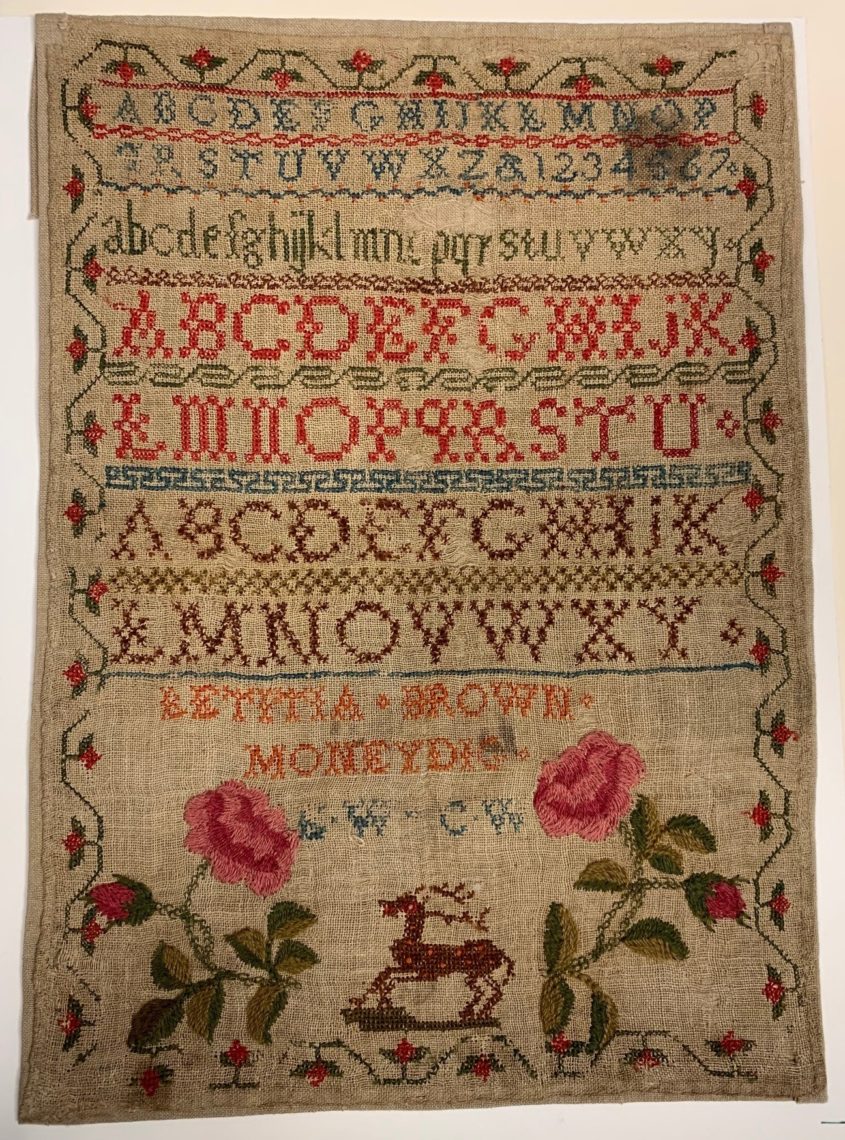
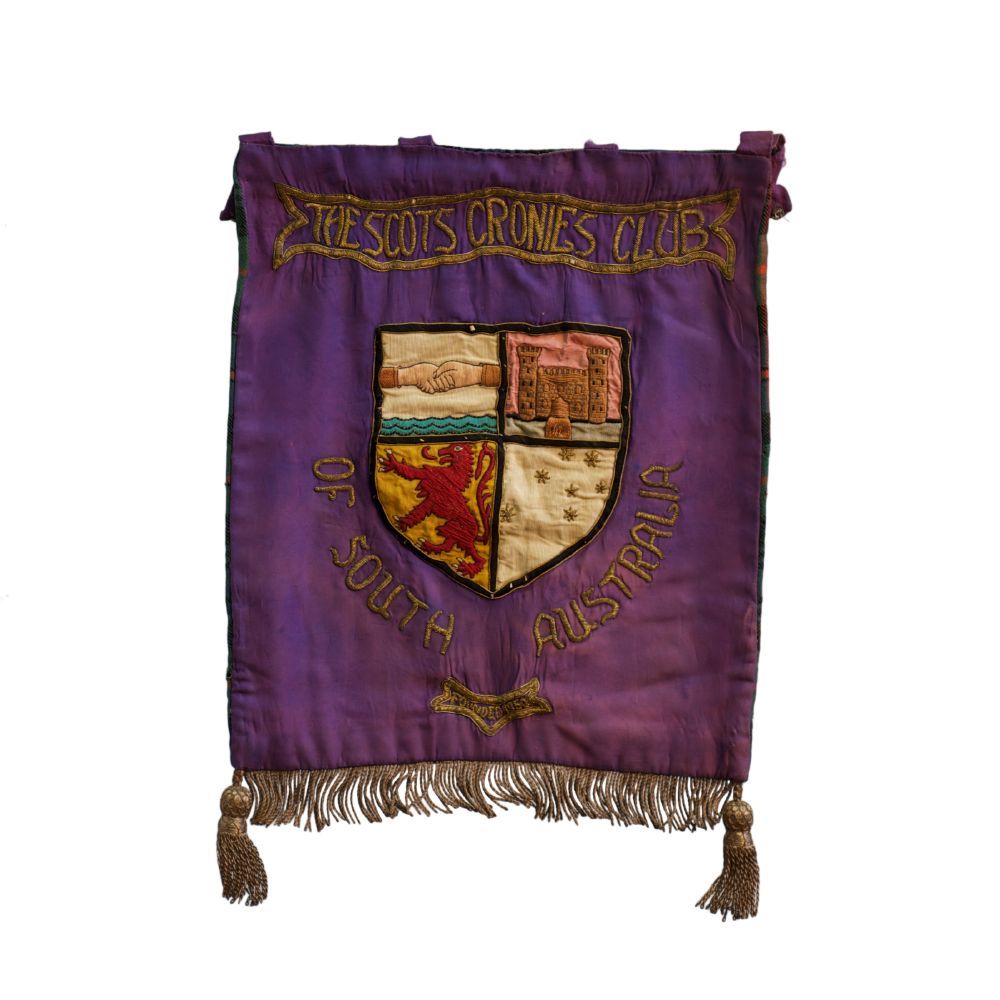
Historically Anglo-Australian culture has relegated needlework to the private sphere and devalued it as a feminine activity: the many practices which come under the umbrella of needlework are commonly defined as the ‘domestic arts’. This view is illustrated in Homer’s The Odyssey when Telemachos says to his mother, Penelope: “Return to your own hall. Tend your spindle. Tend your loom. Direct your maids at work. The question of the bow is for men to settle, most of all for me. I am master here” (cited in Bratich & Brush, 2011:237). Unsurprisingly, the gendered roles and inequalities articulated here have not sat well with many women, nor have they been passively conformed to. From samplers through which ‘ordinary’ women spoke,[3] and sewing circles in which they shared aspects of their ‘private’ lives unlikely to be discussed elsewhere, to more overtly activist contexts in which women and other minorities created suffrage banners,[4] made clothing for runaway slaves,[5] knitted whilst ‘sitting-in’,[6] and stitched AIDS memorial quilts,[7] craft/ing has drawn on the past in its present creation of possible futures.[8]
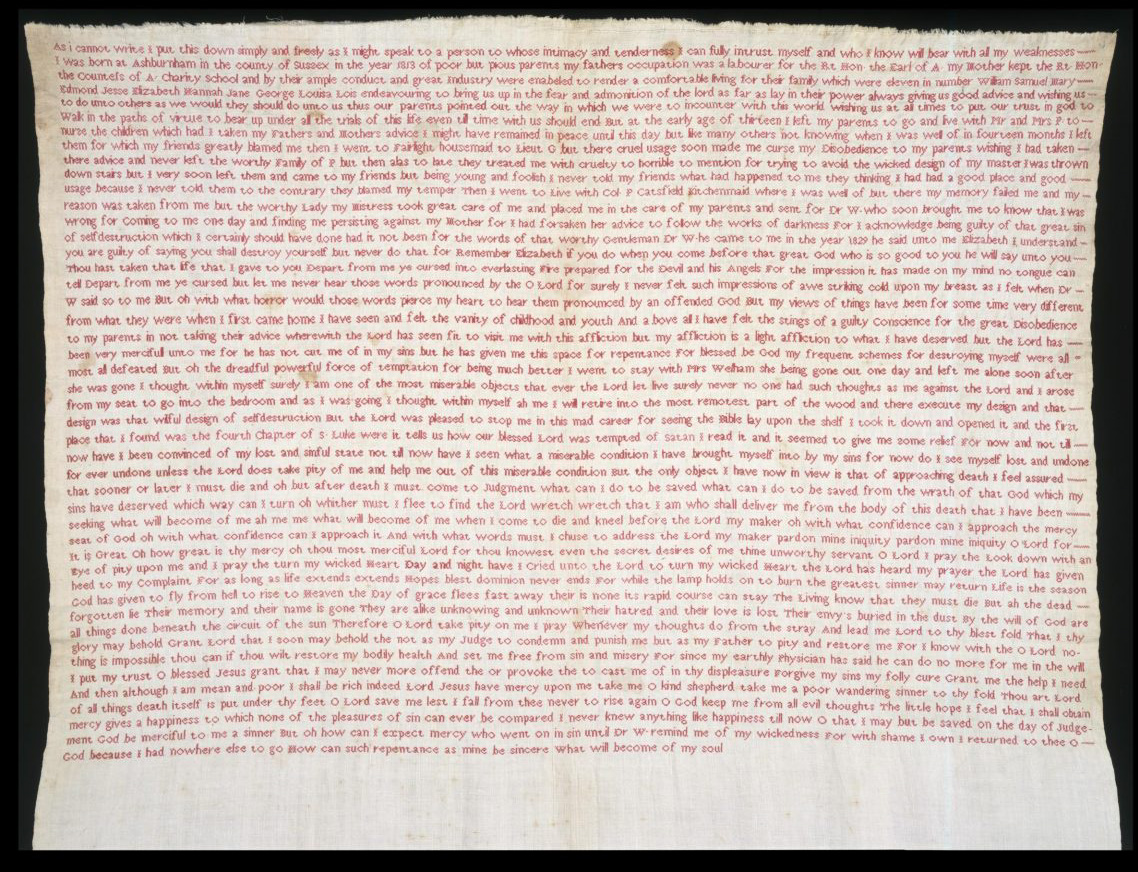
Doing democracy
Craftivism is a term that emerged in the early 2000s and is often attributed to Betsy Greer. The term is a portmanteau of craft + activism, but for Greer craftivism is much more than that: it is a rich concept and practice that reweaves his/stories of craft/ing that confine women and other ‘others’, their labour, and their civic contributions to the margins. According to Greer, “the creation of things by hand leads to a better understanding of democracy because it reminds us that we have power” (Greer, 2014:8). The participatory projects that come under the banner of craftivism, writes Greer, “value democratic processes … use various cross-disciplinary media, and [demonstrate] an ongoing commitment to politicized practices, issues, and actions” (cited in Black & Burisch, 2010:614). It is this that made craftivism such a befitting tool for exploring the question that lies at the heart of Stitch & Resist: How can we continue to resist injustice, engage in the everyday practice of democracy, and take care of our wellbeing in the midst of a pandemic?[9]
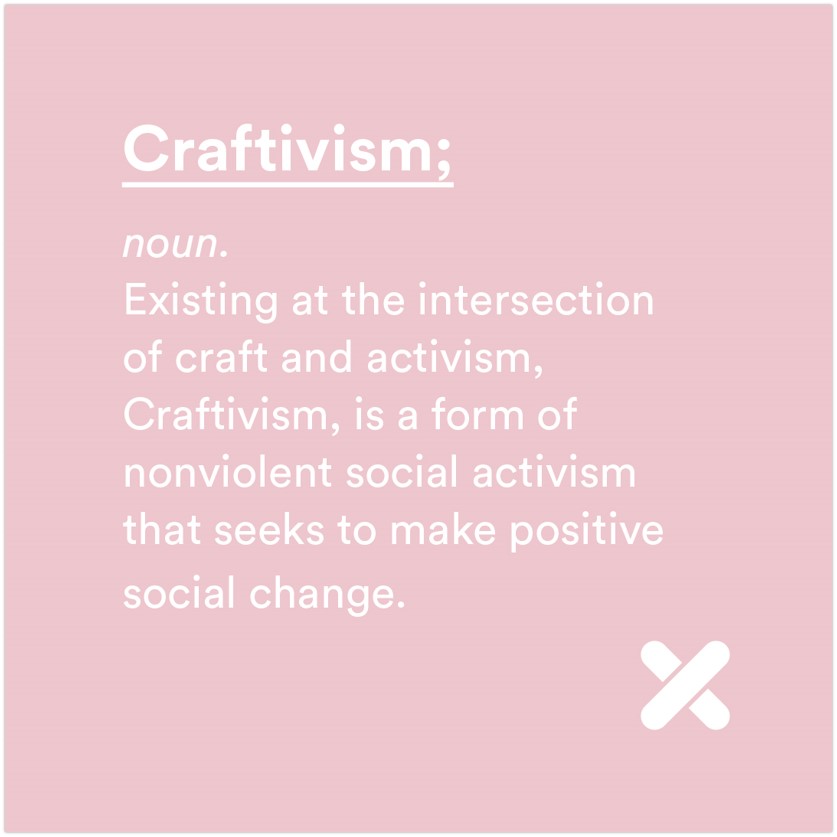
Research shows that like other western democracies, Australia is faced with broad disaffection amongst its citizens and a diminishing sense of “the personal relevance of government and growing dissatisfaction with … democratic processes” (Bennet, Freelon & Wells, 2010:127).[10] We know that among younger people in particular, this is often accompanied by a greater inclination to “embrace issues that connect to lifestyle values that can be shared across social networks” (ibid., 2010:127) rather than to participate in more formal, government-centered activities such as elections.[11] In other words, while participatory democracy and representative democracy are by no means mutually exclusive, the former seems currently to have more appeal to many younger constituents than the latter. Consequently, one of the challenges that CoD faces is to develop strategies that “create meaningful bridges between personal interests [such as needlework] and larger sociopolitical issues, often by means of digital participation” (Literat & Markus, 2020:1414), and to create spaces in which such activities can occur. This is in keeping with the growing conception of “21st century museums as facilitators of civic engagement, agents of social change and moderators of complex issues, built around relevance, reflectiveness and responsibility” (Smithsonian Institute, 2002: 18). Taking this vision seriously, we are confident that CoD’s Stitch & Resist project will lead to great levels of civic engagement by building confidence, knowledge and investment in local, and global political issues and processes for the individuals and communities concerned.
Stitch & Resist
Launched in March 2020 Stitch & Resist was originally conceived as a craftivist project which would facilitate the expression of multiple voices and viewpoints in cross stitch. These would be shared via an online gallery and in an exhibition planned for 2021. In the development stages of the project we approached local community groups and organisations whom we hoped would work with us to address a diverse range of social issues. Of the sixteen that accepted our invitation,[12] most of those who work directly with clients/members agreed to run workshops, whereas others agreed to assist with resources and messaging. Our initial plan was to roll out the project through CoD-run workshops open to the public, closed workshops run by partner organisations in which their clients and members could address issues specific to them, and a suite of resources available on the project website www.stitchandresist.com The aim of the workshops and resources was three-fold: to facilitate civic engagement, to create safe spaces for discussion and for compassionate listening, and to contribute to building and nurturing connection, community, care and wellbeing.
When the Declaration of a Major Emergency was made in South Australia on 22 March 2020, the public Stitch & Resist workshops that CoD had scheduled were cancelled, as were those that were to be hosted by partner organistions. During the first month of lockdown we established regular Zoom meetings with the facilitators from our partner organistions and set up a private Facebook group where we could post work and stories that inspired us, run ideas past each other or, when we needed, just reach out for a chat. As social isolation and online hangouts became the ‘new normal’, we discussed the possibility of online workshops, and of ways to maintain connection and share ideas and works with community members who didn’t have access to, or did not want to use, digital technologies. We established ‘buddy systems’ to ensure that everyone involved was kept in the loop, had regular contact, and could be supported by others. These included regularly calling members who couldn’t attend online meetings, and sending out messages, resources, photographs of works, materials, and so on, via postal mail.
Over the remainder of 2020 Stitch & Resist morphed and grew in ways we could not possibly have anticipated and much of this was due to the pandemic and the needs and affordances it created. We quickly learned from one of our partner-run online groups that even those who did not want to stitch could participate by sketching designs, creating patterns or just sharing ideas and words that become messages for others to stitch. This insight was subsequently taken up by other partner-run groups and led to an increase in participation.
Some of the communities with whom our partner organisations work have been particularly hard hit by unemployment and visa status which makes their members ineligible for certain kinds of government support. In cases where feeding the community was of primary concern, stitching was put on the back burner. Nevertheless, facilitators continued to attend meetings, share information about their communities’ needs, and seek material and emotional support. For example, one group member told us about a refugee group associated with her organisation who were making beanies for their community members; in response, other facilitators put out calls for, collected and/or donated materials. While we may not have thought about it in this way at the time, the activities in which we were engaged worked together to weave alliances and relationships that have nourished and enhanced us all. Stitch & Resist has also contributed to the wellbeing of those not directly involved through the sourcing of materials for a variety of community-run projects, and the beginning of discussions that ripple outwards from those who attended workshops to friends, families and colleagues. We are confident that the forthcoming exhibition and online catalogue, along with the continued existence of the project website, will encourage others to discuss pressing topics and perhaps to become involved in various forms of civic participation.
During
periods in which restrictions were eased we ran face-to-face workshops that
were open to the public as well as attending workshops run by partner
organisations such as Wellbeing SA, the Feast Queer Youth Drop-in, and
Headspace.
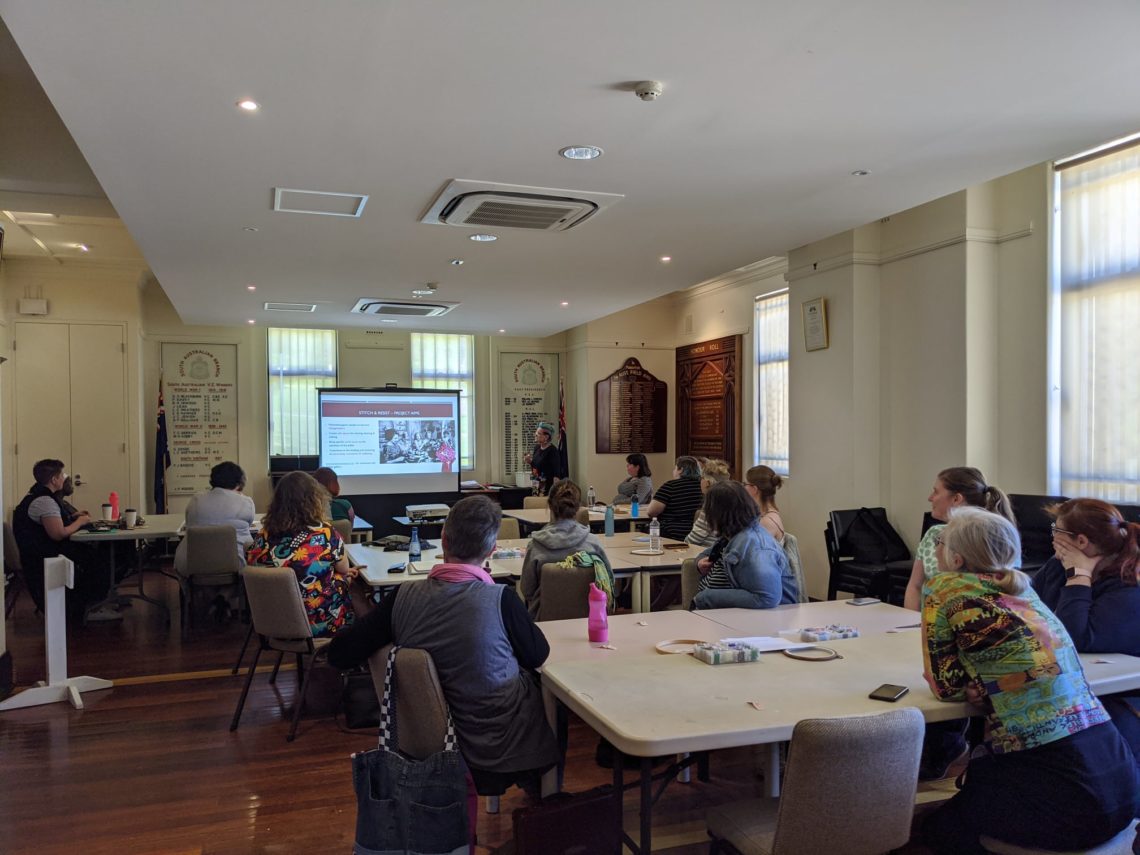
We began these with an introduction to the project’s aims and objectives and invited participants to contribute to conversation, learning, skill-sharing, connection, and social change through the crafting of objects and ideas. Feedback received attests that Stitch & Resist demonstrates to participants that the power to participate in civic engagement is literally in their own hands (or, for that matter, in whatever part of the body they might use to wield the needle). Workshops, both online and in-person, have provided opportunities for participants to express themselves, to reflect on their assumptions, and to connect with and learn from people who in their day to day lives they may not otherwise encounter. This is no small achievement. While there is undoubtedly a paucity of spaces in contemporary culture in which democracy can be productively and respectfully discussed and practiced, the CoD – and in particular the Stitch & Resist project – has generated a civic space that invites and encourages robust discussion of key issues of local, national, and international interest, and connects the everyday agency of individuals and communities to “the political decision-making that is often seen as dislocated from life beyond the parliament” (Message, 2010:387).
Stitch & Resist has shown that civic engagement or active citizenship does not have to involve protesting in the streets, or relying on our elected representatives to create the world we would like to live in. This has been particularly important for participants who attended workshops not because they wanted to make political statements but because they wanted to stitch with others. At a workshop on Kangaroo Island one participant created a piece that spoke of her recent experiences of loss, of the bushfires that had devastated parts of the island, and of Covid 19. Discussing how and why ‘the personal is political’ helped her to feel ‘at home’ at the workshop, and, more importantly, that her experiences, her contributions to the group, and subsequently, the piece she stitched, are valuable and valued.
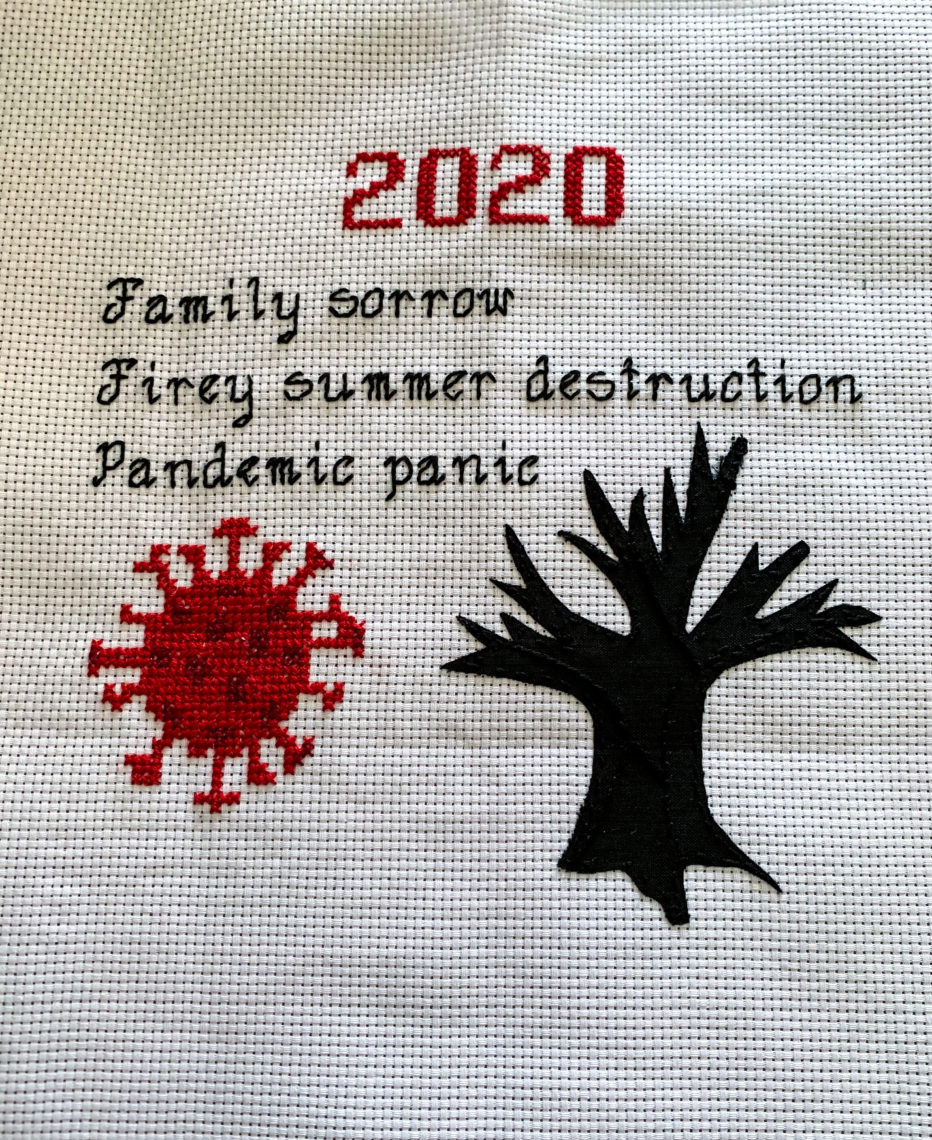
This valuing of individuals, communities, and their civic participation is further supported by the fact that the works created are shared on the Stitch & Resist online gallery, will be displayed in an exhibition, and will, in some cases, became part of the State History Collection.[13] Through these mechanisms and the documenting of the project, future generations will be able to access the thoughts, experiences, concerns of participants, and the objects they have crafted. In doing so they will undoubtedly gain important insights about life in South Australia in 2020. Given that one of the aims of the craft/ing (both the making and the works themselves) was to provoke thought, discussion, reflection, we hope that the beautiful works created by so many different hands will also incite such reactions in those who view them long after the coronavirus pandemic has been relegated to the annals of history.
References
Bennett, W. Lance, Deen Freelon & Chris Wells (2010) ‘Changing Citizen Identity and the Rise of a Participatory Media Culture,’ in Handbook of Research on Civic Engagement in Youth, L. R. Sherrod, J. Torney-Purta, & C. A. Flanagan (eds.), New Jersey: Wiley, pp.123-52.
Black, Anthea & Nicole Burisch (2010) ‘Craft hard, die free: Radical curatorial strategies for craftivism in unruly contexts,’ in The craft reader, G. Adamson (Ed.), Oxford: Berg, pp. 609–619.
Bratich, Jack Z. & Heidi M. Brush (2011) ‘Fabricating Activism: Craft-work, Popular Culture, Gender,’ Utopian Studies 22:2, p.233-60.
Close, Samantha (2018) ‘Knitting Activism, Knitting Gender, Knitting Race,’ International Journal of Communication 12, pp.867-89.
Literat, Iona & Sandra Markus (2020) ‘”Crafting a way forward”: online participation, craftivism and Ravelry’s Pussyhat Project group,’ Information, Communication & Society 23:10, pp.1411-1426.
Message, Kylie (2010) ‘The Museum of Australian Democracy: A House for the People?’, Australian Historical Studies 41:3, pp.385-95.
Office of Policy and Analysis (2002) 21st Century Roles of National Museums: A Conversation in Progress, USA: Smithsonian.
Parker, Rozsika (1984) The Subversive Stitch: Embroidery and the Making of the Feminine, London: The Women’s Press
[1] As part of the project, and to mark International Democracy Day we hosted a webinar entitled Crafting Democracy in which Stitch & Resist featured alongside the work of two well-known Australian craftivists, Tal Fitzpatrick and Sera Waters. The webinar is on the HTSA youtube channel: https://www.youtube.com/watch?v=tbxcTm1-iPo
[2] https://www.youtube.com/channel/UCMXHzYhSfHoMKPI2652Pclw/videos
[3] For discussion of a fascinating cross stitched account of domestic abuse created in 1830 see Lizzie Emery’s blog post on the CoD website: https://www.centreofdemocracy.sa.gov.au/2021/02/as-i-cannot-write/
[4] https://blog.spoonflower.com/2020/02/crafting-a-voice-the-history-of-suffrage-banners/
[5] https://graphicarts.princeton.edu/2018/05/05/abolitionist-sewing-circles/
[6] https://standupandspit.wordpress.com/2016/12/17/greenham-common-and-knitting/
[7] https://blog.tepapa.govt.nz/2018/11/28/the-power-of-stitching-names-during-the-aids-crisis/
[8] See Rozsika Parker’s seminal text The Subversive Stitch: Embroidery and the Making of the Feminine (1984)for a thorough exploration of women’s historical relationship to needlework.
[9] Close has argued that “the practices of participatory culture map well onto craftivism’s ‘key practices of democratic process, wide-ranging media use, [and] commitment to political action’ (2018: 5)” and hold significant civic potential.
[10] https://www.pewresearch.org/fact-tank/2020/02/27/how-people-around-the-world-see-democracy-in-8-charts/ For an Australian-focused report see https://www.democracy2025.gov.au/documents/Democracy2025-report1.pdf and https://apo.org.au/sites/default/files/resource-files/2018-07/apo-nid193916.pdf
[11] This shift away from what Bennett et al call Dutiful Citizenship and towards Actualizing Citizenship is by no means unique to Gen Y or Gen Z, nor is it as simple as wholly replacing one mode of participation with another.
[12] The organisations and community groups with whom we partnered work with refugees and asylum seekers, LGBTIQA+ youth and elders, Aboriginal women, Vietnamese women, multicultural communities, Arabic speaking communities, D/deaf communities, unions, rural communities, bushfire-effected communities, and communities seeking support around mental health and wellbeing.
[13] The original and digital works collected will contribute to the HTSA’s Covid 19 Collecting Project https://history.sa.gov.au/covid19-collecting/ and augment the organisation’s commitment to documenting history in the making through contemporary collecting.





